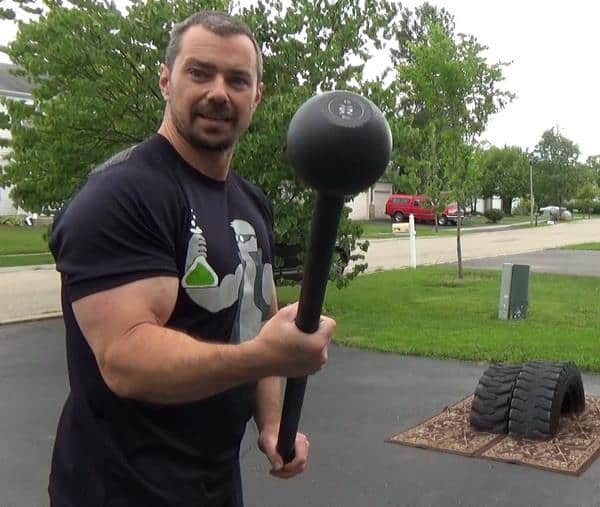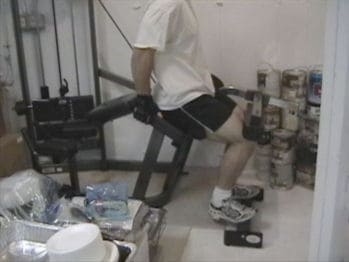Most twisting ab exercises are TERRIBLE for your lower back…seriously. Any oblique work you get out of them is offset by the potential damage you can do to your spine with a loaded twisting movement.
The deep muscles of the core (the obliques and transverse abdominis) are best worked in an “anti-rotation” capacity…which means working AGAINST that twisting movement that is so damaging to the lower back.
That’s where this exercise comes into play…I call it a 2 Dumbbell Ball Twist, but in reality it’s a ball ANTI-twist.
Because what you’re going to do is shift a pair of dumbbells to either side of your body, doing your best NOT to twist during the movement.
It’s tough and EXTREMELY effective.
For this exercise, you will need two dumbbells and a Swiss Ball. Start light…I’m just using a pair of 35 lb dumbbells in the demo.
Lie on your back with your knees bent and your feet fairly wide apart – you’ll need a good base of support for this exercise so that you don’t roll off to the side of the ball.
Hold two equal-weight dumbbells at arms-length directly above you. Keep them pushed TIGHTLY together while doing this exercise (if they’re separated, they’ll move around more, making the exercise less efficient).

Now, keeping your head facing directly up/forwards and your hips horizontal, lower both of the dumbbells slowly and under complete control down to the left. Hold your breath and tighten up your midsection as you come down to the fully-rotated position.
Prepare to push hard against the ground with your left foot to maintain your balance.

Your left arm is going to bend to about 90 degrees at the elbow as you lower the dumbbells to the side while your right arm should stay relatively straight.
Torque is what makes the exercise so valuable….you’re using the obliques to FIGHT the potential rotation that dumbbells are trying to force into your core. Bending your lower arm is critical to keeping the right position.
Since you’re using two separate dumbbells, it’s going to create a very different stress on the entire abdominal area than anything you’ve experienced before.
When you’re at the bottom, your upper left arm will be contacting the surface of the ball (don’t let it rest…keep tension on!). Now reverse the direction by simultaneously pulling with your right arm and pushing with your left arm. The right arm movement is similar to a rear delt lateral while the left arm movement is similar to a dumbbell press.
Remember to keep the dumbbells pushed together tightly! The opposing tension in the abs really puts a lot of torque across the whole area. Be very sure you’re not just pushing with the bottom arm but that you’re also pulling with the top arm.
I recommend holding your breath briefly as you come down into the bottom position, to maximize core stability and strength. If you breath at that point, it will destabilize the core. Breathing out should happen as you bring the dumbbells back up…through pursed lips, as though blowing up a balloon.
It’s very important that you DO NOT bounce out of the bottom position….try to feel a stretch in the right side as you use a pause then a deliberate change of direction.
Even though this exercise is designed to be far more effective and safer than a normal twist, if you have any lower back pain issues, this exercise does put some degree of stress on the lower back. If you do try it, go very light and take it very slowly.
Bring the dumbbells back up to the top position.

Then come down to the right.

Tricks:
1. Changing the arc
You can bring the dumbbells down at various angles to the torso to change where the exercise hits your abs. By bringing them down higher up beside your head, you’ll hit the upper areas of your obliques. By bringing them down towards your hip, you’ll hit the lower areas of your obliques. Just remember to always keep your head looking straight up and set your feet wide apart for the best base of support.
2. How to use a flat bench instead
You can also do this exercise on a flat bench instead of a ball, if you don’t have access to a ball or prefer a more solid surface to work on. Instead of lying flat on the bench as you normally would for a bench press, you’ll be resting only your upper back on the end of the bench.
To get into this position, sit on the very end of the bench. Now move your butt off the bench and squat down in front of it. Lean back and place your upper back on the bench end. Keep your hips down and set your feet fairly wide apart.
This is the position you should maintain while doing the exercise. The bench is a more solid surface but it is just as effective for the exercise. One major difference is that there won’t be any surface to contact the upper arm of the bottom arm as you lower the weight down. Keep an eye on how far down you go to the side. All the other techniques still apply.
3. When using heavier weight…
You can shift your upper body somewhat to the other side of the ball. If you’re using a heavy weight, you’ll need to do that in order to stay on the ball. The increased resistance will make up for it.
Be extra careful the dumbbells don’t separate. It’ll be much harder to control heavier dumbbells if they do.
As you rotate back up, exhale through pursed lips to keep stability in your abs as you let air out and so that you don’t pass out.
Push VERY hard with the same side leg as the weight is on. You’ll need all the help you can get.
CONCLUSION
This is an excellent deep core exercise that will target the anti-rotation function of the obliques and transverse abdominis. You can use it to build serious strength and stability that will carry over to just about every movement you do in the gym, on the field and life in general!

Nick Nilsson is known in the fitness industry as the “Mad Scientist of Muscle,” and for good reason! For more than 28 years, Nick has been creating unique, new exercises and training techniques and putting together some of the most innovative muscle-building and fat-loss programs available anywhere.









